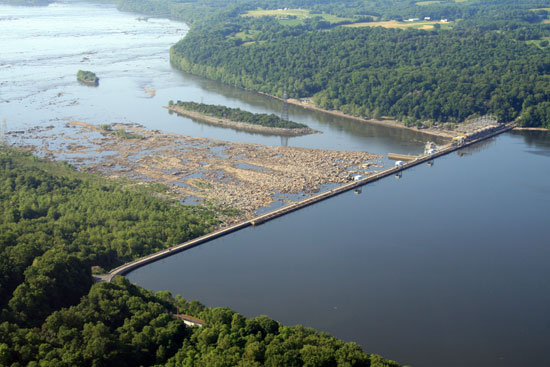Sediment reservoirs in lower Susquehanna reach capacity, deliver more pollutants into Bay
Filling reservoirs behind three dams overshadow pollution reduction progress.
Sediment reservoirs near the mouth of the Susquehanna River are filling up faster than researchers expected, posing a new obstacle for improving water quality in the Chesapeake Bay.
As the holding areas behind the lower Susquehanna's three dams reach capacity, their ability to trap upriver sediment and the phosphorous that is often attached wanes, and the sediment that is held grows more and more likely to flow out of the reservoirs and into the river.

Image courtesy Jane Thomas/Integration and Application Network/University of Maryland Center for Environmental Science.
According to a report released by the U.S. Geological Survey (USGS), strong storms, severe flooding and faster-moving water have turned the one-time pollutant blockers into less effective gates.
The Susquehanna delivered more phosphorous and sediment into the Bay last year than it has in more than three decades of monitoring. The past 15 years have seen a 55 percent increase in phosphorous entering the Bay from the river and a 97 percent increase in sediment. And while nitrogen flow has dropped, it shows a jump during large storms--like Tropical Storm Lee in 2011 or Hurricane Ivan in 2004--and the flooding that follows.
Excess nutrients and sediment can harm fish, shellfish and underwater grasses. Nitrogen and phosphorous fuel the growth of algae blooms that rob water of oxygen and, with suspended sediment, cloud the water and block the sunlight that plants need to grow.
A previous USGS report cited improvements in nutrient and sediment trends as a sign of improving Bay health. The USGS has seen significant reductions in nutrient and sediment concentrations upstream of the reservoirs, which reflect the positive impacts of conservation efforts in the Susquehanna watershed. But the filling reservoirs behind the Safe Harbor and Holtwood dams in Pennsylvania and the Conowingo Dam in Maryland overshadow the pollution reduction progress that is being made.
The Lower Susquehanna River Watershed Assessment team, composed of federal, state and regional partners and administered by the U.S. Army Corps of Engineers, is exploring ways to expand the reservoirs' capacity.
Learn more about the flow of nitrogen, phosphorous and suspended sediment from the Susquehanna River into the Bay.

Comments
save the rivers
Thank you!
Your comment has been received. Before it can be published, the comment will be reviewed by our team to ensure it adheres with our rules of engagement.
Back to recent stories